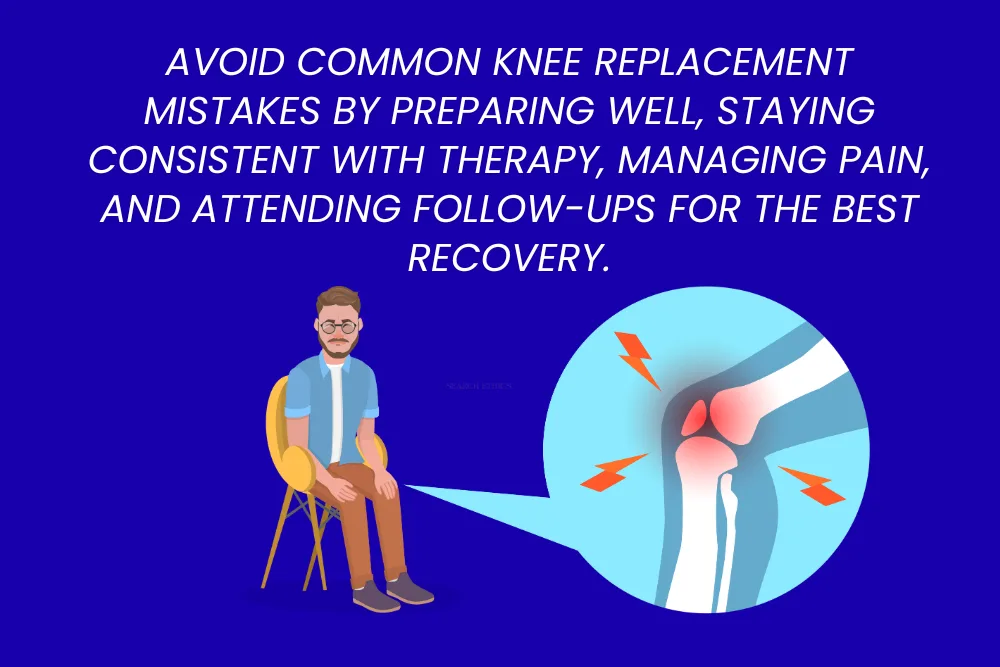Now Reading: Top 5 Mistakes After Knee Replacement
-
01
Top 5 Mistakes After Knee Replacement
Top 5 Mistakes After Knee Replacement

Knee replacement surgery can be a life-changing procedure for patients suffering from severe knee pain and arthritis. It is generally considered one of the most successful orthopedic operations, helping people regain mobility and return to the activities they enjoy. However, not everyone experiences the desired outcome after surgery. Unfortunately, some patients are unhappy with the results and even regret having the surgery in the first place.
Why does this happen? In many cases, it is because of common mistakes made during the recovery process. These mistakes can significantly impact your ability to heal, regain strength, and restore full function in your knee. In this article, we will discuss the top five mistakes after knee replacement and how you can avoid them to achieve the best possible results.
Mistake 1: Blind Faith – Going Into Surgery Without Understanding It
One of the most common mistakes patients make is agreeing to surgery without understanding what it involves. Some people decide to have a knee replacement simply because someone suggested it or because their surgeon said it was necessary. They do not take the time to learn about the procedure, its challenges, or the recovery process.
Many patients do not realize how major this surgery is or how long and demanding recovery can be. Others may not actually need surgery yet because they have not tried conservative treatments like physical therapy, medications, or injections.
Before considering surgery, make sure you truly need it. You should have significant arthritis, noticeable limitations in daily activities, and failure of non-surgical treatments. Another critical part of preparation is optimizing your health. Conditions like uncontrolled diabetes, smoking, and obesity can increase the risk of complications such as infections or blood clots. Addressing these issues before surgery can improve your outcome and reduce risks.
Mistake 2: Overdoing or Underdoing Physical Activity
After knee replacement surgery, staying active is essential, but balance is key. Doing too little can slow your recovery, while doing too much can lead to pain, swelling, and setbacks.
Some patients mistakenly believe they need to rest completely and spend most of their time lying down after surgery. This is not true. Knee replacement is not an illness; it is a procedure to help you move better. Remaining inactive can lead to stiffness and poor recovery.
On the other hand, pushing yourself too hard can be equally harmful. Overexertion can cause increased pain and swelling, making it harder to progress. Recovery is different from athletic training. When you are young and healthy, your body can recover from intense activity. After surgery, your body is in healing mode, and the margin for error is much smaller.
To avoid this mistake, follow your surgeon’s and physical therapist’s advice. Progress should be steady and controlled. If you notice increased pain or your range of motion begins to decrease, it is a sign you may be doing too much and need to slow down.

Mistake 3: Neglecting Physical Therapy
Physical therapy is one of the most important factors in achieving a successful outcome after knee replacement. When you wake up from surgery, you have one critical opportunity to regain full motion.
The first six weeks after surgery are the most important for restoring range of motion. After 12 weeks, it becomes nearly impossible to make significant improvements. Physical therapy should begin immediately and focus first on regaining flexibility. Strength building comes next, followed by improving endurance.
If you neglect therapy or fail to do your exercises, your knee may become stiff and painful. In many cases, surgeons cannot correct this later, and patients are left with permanent limitations. To avoid this mistake, attend every therapy session and follow your home exercise program diligently.
Mistake 4: Ignoring Pain and Swelling
Pain and swelling are expected after knee replacement, but they should gradually improve over time. If they do not, this can delay your recovery.
Pain needs to be managed well enough to allow you to sleep, walk, and participate in therapy. You should not expect your pain level to be zero, but it should be controlled. If your pain is severe and preventing you from doing therapy, contact your doctor. Adjustments to your pain management plan can make a big difference.
Swelling is also normal, but it should decrease each day. Persistent or worsening swelling can interfere with physical therapy and increase the risk of complications such as blood clots. Use methods like elevation, icing, and compression to control swelling. If you notice that swelling is not improving or is getting worse, consult your surgeon immediately.
Mistake 5: Skipping Follow-Up Appointments
Follow-up visits are essential both in the short term and long term. During the early postoperative period, your surgeon monitors your progress, checks your incision, and ensures your implant is in good position. These appointments also allow your doctor to identify issues like stiffness or infection early.
Missing these appointments can delay necessary interventions. For example, if you are not improving with therapy, your doctor might recommend a procedure called manipulation under anesthesia to restore motion. This is only effective if done early, which makes follow-up visits critical.
If your knee becomes red, swollen, or starts draining fluid, seek medical attention right away. Quick action can prevent serious complications like infections or blood buildup in the joint.
Final Thoughts
Avoiding these top five mistakes after knee replacement can dramatically improve your recovery. Take the time to prepare for surgery, follow your rehabilitation plan, manage pain and swelling, and keep up with your appointments.
Remember that knee replacement recovery takes time. Most patients see significant improvement within six to twelve months, but patience and consistency are key. By avoiding these mistakes, you can maximize your results and return to an active, pain-free lifestyle.
You may also like to knoe about how knee replacement is done
Frequently Asked Questions
How long does it take to recover from knee replacement surgery?
Recovery usually takes six to twelve months. Improvements in strength and endurance can continue for up to a year.
What is the most important part of recovery?
Regaining range of motion in the first six weeks is the most critical factor for long-term success.
When should I call my doctor after surgery?
Contact your surgeon if you experience severe pain, increased swelling, fever, redness, or fluid drainage from the incision site.
Dony Garvasis is the founder of Search Ethics, a platform dedicated to transparency, authenticity, and ethical digital practices. With over six years of experience in SEO and digital marketing, I provide expert content on automobiles, technology, gadgets, and online strategies. My mission is simple: Ethical Search, Genuine Results—ensuring users worldwide receive credible, useful, and up-to-date content.










